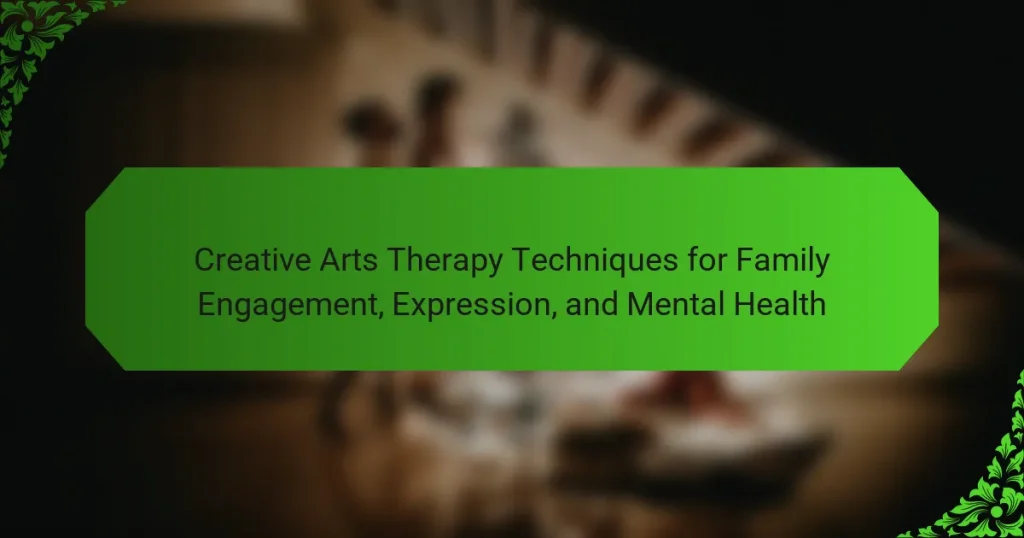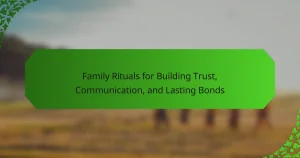Creative arts therapy techniques enhance family engagement, expression, and mental health. These methods include art therapy, music therapy, drama therapy, and dance/movement therapy. Each approach fosters creativity and effective communication among family members. By integrating structured activities at home, families can strengthen their bonds and promote emotional well-being.
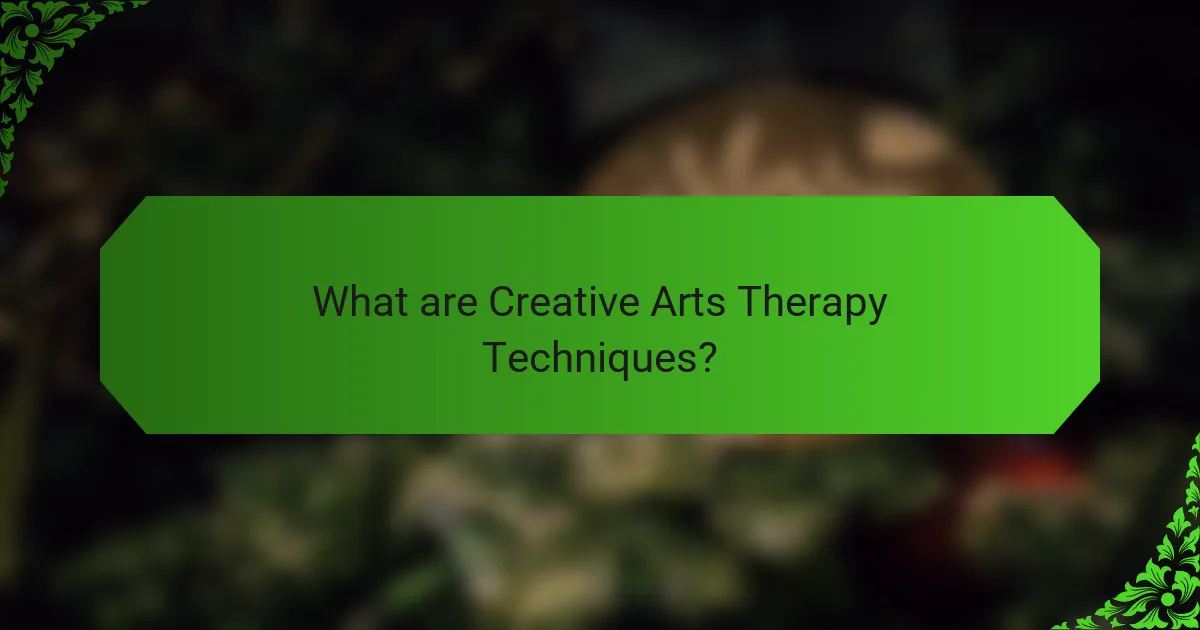
What are Creative Arts Therapy Techniques?
Creative arts therapy techniques enhance family engagement, expression, and mental health through various methods. Techniques include art therapy, music therapy, drama therapy, and dance/movement therapy. Each method fosters creativity, allowing families to communicate emotions and experiences effectively. Art therapy encourages visual expression, while music therapy promotes auditory engagement. Drama therapy allows for role-playing scenarios, facilitating discussions on personal issues. Dance/movement therapy integrates physical movement to express feelings, enhancing emotional connections among family members. These techniques support mental well-being and strengthen family bonds.
How do these techniques promote family engagement?
Creative arts therapy techniques enhance family engagement by fostering communication, emotional expression, and mutual understanding. These methods create a safe space for families to explore feelings together. Techniques like art, music, and drama facilitate non-verbal expression, allowing family members to connect on deeper levels. This engagement leads to improved mental health outcomes, as families learn to support one another effectively.
What role does expression play in creative arts therapy?
Expression plays a crucial role in creative arts therapy by facilitating emotional release and communication. It allows individuals to explore feelings that may be difficult to articulate verbally. Engaging in creative activities, such as painting or music, fosters a safe environment for self-expression. This process can enhance family engagement by promoting shared experiences and understanding. Furthermore, expression through art can significantly improve mental health by reducing anxiety and depression, leading to better emotional regulation.
How do these techniques support mental health?
Creative arts therapy techniques enhance mental health by fostering emotional expression and family connection. These techniques promote communication, reduce anxiety, and build resilience. Engaging in creative activities allows individuals to process feelings, leading to improved mental well-being. Research indicates that art therapy can significantly lower symptoms of depression and anxiety, offering a unique approach to mental health care.
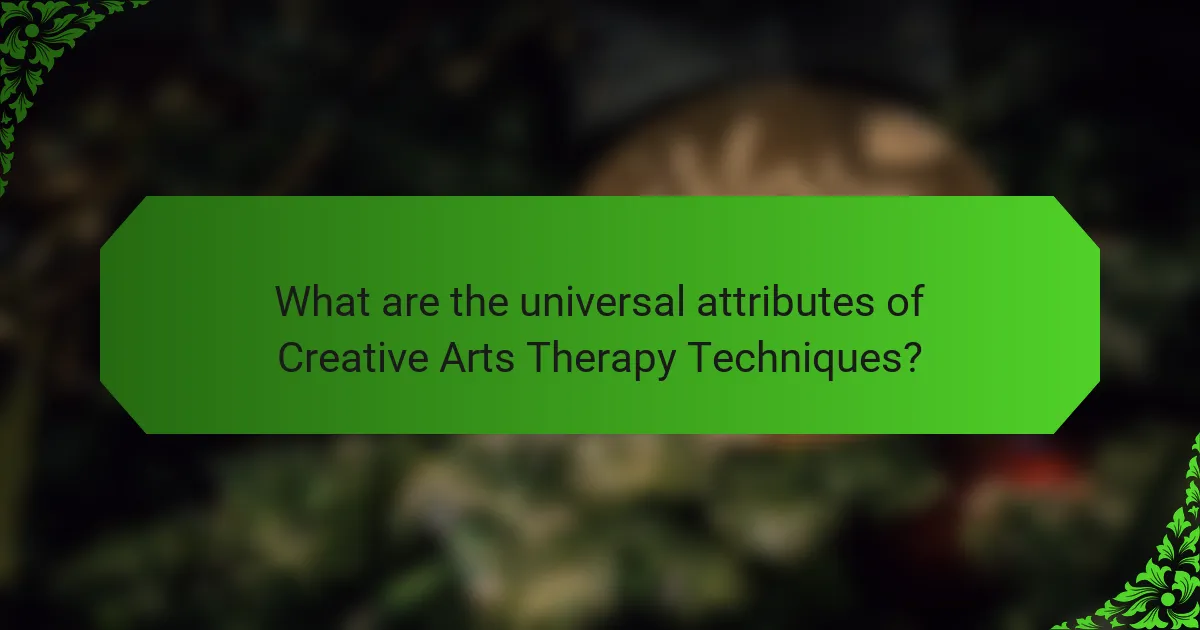
What are the universal attributes of Creative Arts Therapy Techniques?
Creative Arts Therapy Techniques universally enhance emotional expression, foster engagement, and improve mental health. These techniques often include art, music, drama, and dance, promoting self-discovery and healing. A unique attribute is their adaptability to individual needs, making them effective across diverse populations. Root attributes include the focus on creativity and expression, which are essential for personal growth and connection within family dynamics.
What are the core forms of expression used in creative arts therapy?
Creative arts therapy employs various forms of expression to enhance family engagement and mental health. Common techniques include visual arts, music, drama, dance, and movement. Each form serves as a unique medium for individuals to articulate emotions and experiences creatively. Visual arts, like painting and drawing, facilitate non-verbal expression, while music therapy utilizes sound to evoke feelings and memories. Drama therapy encourages role-playing and storytelling, promoting empathy and perspective-taking. Dance and movement therapy allow for physical expression of emotions, fostering body awareness and connection. These techniques collectively support therapeutic goals and strengthen family dynamics.
How does creativity facilitate communication within families?
Creativity enhances communication within families by fostering open expression and emotional connection. Engaging in creative arts therapy techniques, such as painting or storytelling, allows family members to share feelings in a non-verbal manner, reducing barriers to communication. This approach promotes understanding and empathy, leading to healthier relationships. The unique attribute of creativity lies in its ability to transform difficult emotions into tangible expressions, facilitating dialogue that might otherwise be challenging. As a result, families can navigate conflicts and strengthen bonds through shared creative experiences.
What are the common goals of these therapy techniques?
Creative arts therapy techniques aim to enhance family engagement, facilitate expression, and improve mental health. Common goals include fostering communication, building trust, and promoting emotional well-being. These techniques often encourage creativity, allowing family members to express feelings in a non-verbal manner. As a result, participants may experience reduced anxiety and improved relationships.
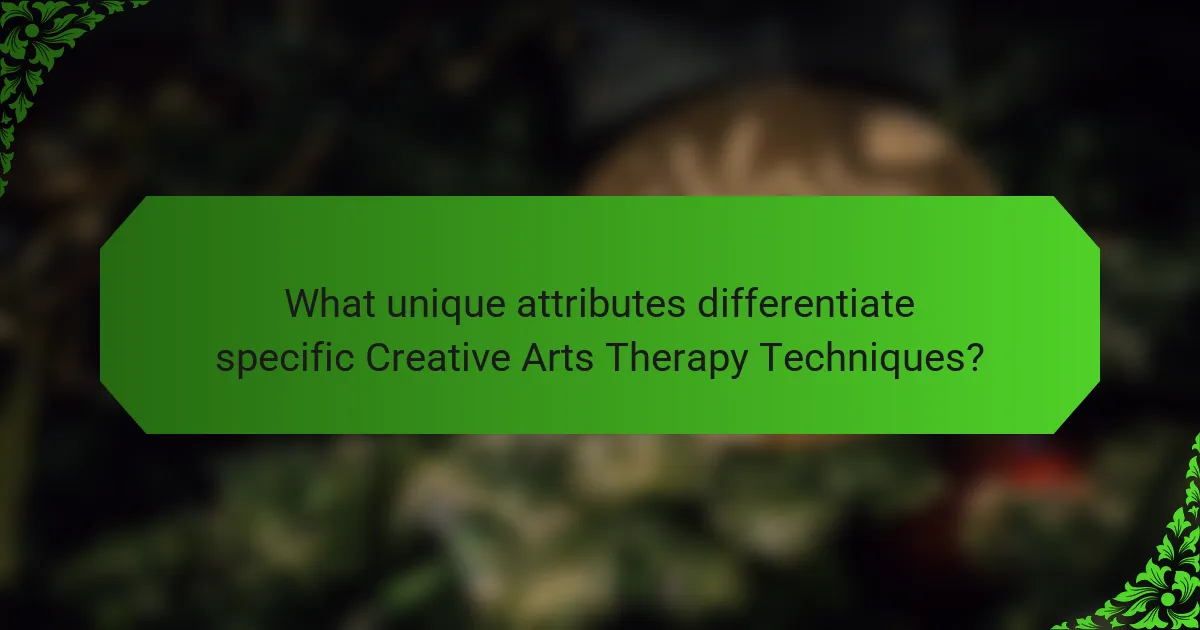
What unique attributes differentiate specific Creative Arts Therapy Techniques?
Creative Arts Therapy Techniques vary significantly in their unique attributes, enhancing family engagement and mental health. Techniques such as art therapy emphasize visual expression, while music therapy focuses on auditory experiences. Drama therapy uniquely incorporates role-playing, fostering empathy and communication. Dance/movement therapy emphasizes physical expression, addressing emotional and psychological needs. These distinct approaches cater to diverse preferences, ensuring effective engagement and expression in therapeutic settings.
What specific art forms are most effective for family engagement?
Creative arts therapy techniques such as music therapy, art therapy, drama therapy, and dance/movement therapy are highly effective for family engagement. These art forms foster communication, enhance emotional expression, and strengthen family bonds.
Music therapy encourages families to connect through shared musical experiences, promoting emotional release and bonding. Art therapy allows family members to express feelings visually, facilitating discussions around emotions. Drama therapy enables role-playing, helping families navigate conflicts and understand each other’s perspectives. Dance/movement therapy promotes physical connection and non-verbal communication, enhancing relational dynamics.
Incorporating these techniques can lead to improved mental health outcomes and deeper familial relationships.
How do different cultural backgrounds influence therapeutic outcomes?
Cultural backgrounds significantly shape therapeutic outcomes in creative arts therapy. They influence family engagement, expression styles, and mental health perceptions. For instance, collectivist cultures may emphasize group activities, enhancing family cohesion. Individualistic cultures might prioritize personal expression, fostering self-identity. Understanding these dynamics can improve therapy effectiveness and tailor approaches to diverse needs.
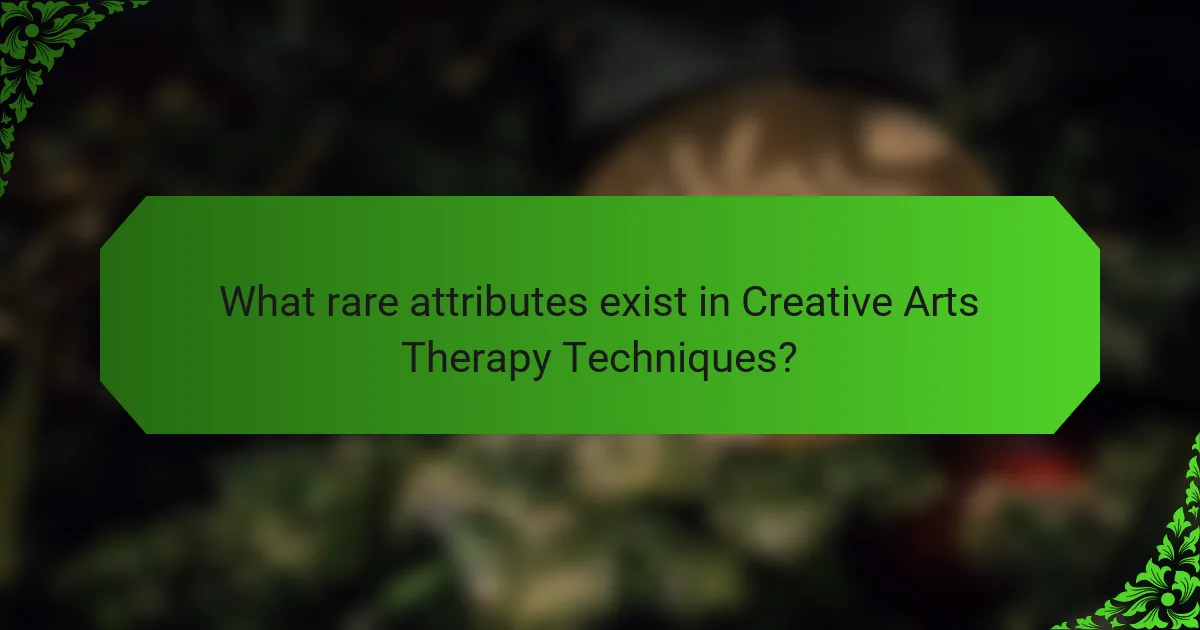
What rare attributes exist in Creative Arts Therapy Techniques?
Creative Arts Therapy techniques exhibit rare attributes that enhance family engagement and mental health. One rare attribute is the use of culturally specific art forms, which resonate deeply with individual family histories. Another rare trait is the integration of technology, such as virtual reality, to create immersive experiences that facilitate expression. Additionally, some techniques uniquely incorporate nature-based elements, promoting healing in outdoor settings. These attributes collectively contribute to the effectiveness of therapy in diverse contexts.
What innovative practices are emerging in the field?
Innovative practices in creative arts therapy focus on integrating technology and community engagement. Techniques such as digital storytelling and virtual reality art sessions enhance family participation and emotional expression. These methods leverage unique attributes like accessibility and interactivity, fostering mental health in diverse settings. Additionally, collaborative art projects promote bonding and communication among family members, addressing root attributes of connection and support. Emerging trends emphasize personalized approaches, allowing therapists to tailor sessions based on individual family dynamics and needs.
How can technology enhance creative arts therapy?
Technology enhances creative arts therapy by providing innovative tools that facilitate expression and engagement. Digital platforms enable remote participation, allowing families to connect regardless of location. Virtual reality can create immersive experiences that foster emotional exploration. Additionally, apps designed for art creation offer users diverse mediums to express feelings, promoting mental health. These advancements support personalized therapy approaches, making sessions more accessible and effective.
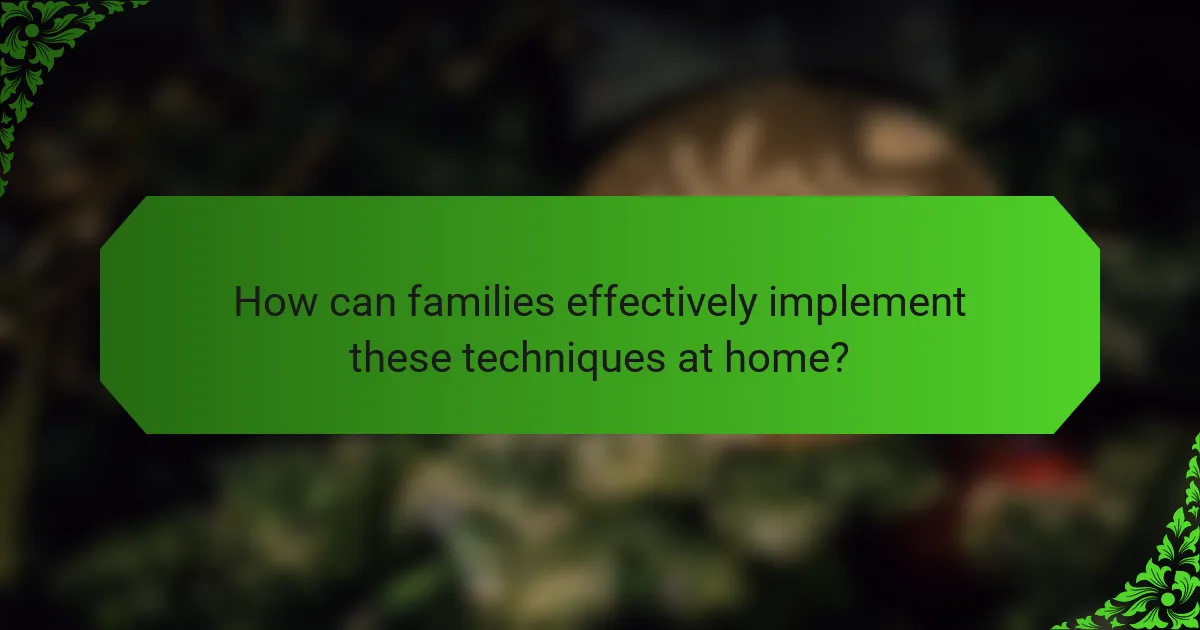
How can families effectively implement these techniques at home?
Families can effectively implement creative arts therapy techniques at home by incorporating structured activities that promote engagement and expression. Start with simple art projects, such as drawing or painting together, which encourage open communication and emotional sharing. Schedule regular family art nights to foster routine and connection. Use storytelling through art to explore feelings and experiences, allowing each family member to contribute their unique perspective. Create a safe space for expression, free from judgment, where everyone can share their artwork and thoughts. This approach supports mental health by enhancing emotional awareness and strengthening family bonds.
What are best practices for integrating creative arts into daily life?
Integrating creative arts into daily life enhances family engagement and mental health. Start by scheduling regular family art sessions, allowing everyone to express themselves freely. Use various mediums, such as painting, music, or storytelling, to cater to different preferences. Encourage sharing of creations to foster communication and strengthen bonds. Incorporate arts into daily routines, like creating themed dinners or crafting during family time, to make creativity a habit. Lastly, explore community art events together to inspire collaboration and connection.
What common mistakes should families avoid when using these techniques?
Families should avoid common mistakes like lack of communication, setting unrealistic expectations, and neglecting individual needs. Engaging all members in creative arts therapy requires open dialogue to ensure everyone feels included. Unrealistic expectations can lead to frustration; instead, focus on gradual progress. Neglecting individual needs may hinder expression, so consider everyone’s unique preferences and comfort levels in the process.
How can families measure the impact of creative arts therapy on mental health?
Families can measure the impact of creative arts therapy on mental health through observation, feedback, and assessments. Regularly tracking emotional responses during sessions provides insight into progress. Utilizing standardized mental health assessments before and after therapy can quantify changes. Engaging in discussions about experiences fosters deeper understanding of therapeutic benefits. Additionally, documenting creative expressions can reveal shifts in emotional well-being and coping strategies.
What expert insights can guide families in their therapeutic journey?
Creative arts therapy techniques can significantly enhance family engagement and expression in mental health journeys. Techniques such as art, music, and drama therapy foster communication, encourage emotional expression, and strengthen family bonds. These methods allow families to explore feelings in a safe environment, facilitating understanding and connection. Engaging in creative activities together can lead to improved mental health outcomes, as families learn to support one another while navigating challenges.
